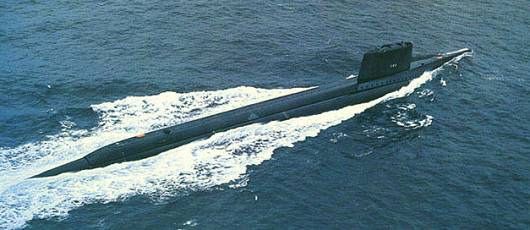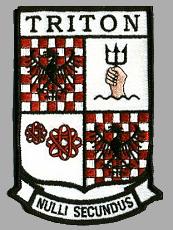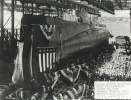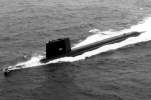

 |
Search the Site with

|
 |  |
USS TRITON - the fifth ship in the Navy to bear the name - was in many ways a unique ship. With a length of 447 feet (136.3 meters), she was the longest submarine at that time and she was the Navy's first submarine accommodating three decks in her hull. Her propulsion system included two nuclear reactors which is also unique in US submarine construction.
The TRITON was built and commissioned as a nuclear-powered radar picket submarine (SSRN). Upon the demise of the Navy's radar picket submarine program, TRITON was redesignated SSN 586 on March 1, 1961, and entered the Portsmouth Naval Shipyard in June 1962 for conversion to an attack submarine. Conversion was completed in March 1964. For the following 5 years, the TRITON served in her new role but due to the high costs involved in operating the submarine and the fact, that TRITON was not able to carry the latest submarine weapons system, the Navy decided to decommission the TRITON in May 1969. The submarine was subsequently placed in the inactive fleet at Norfolk, Va., where TRITON remained into 1986 when she was stricken from the Navy list. Towed to the Puget Sound Naval Shipyard at Bremerton, Wash., the TRITON subsequently awaited her turn in the Navy's Nuclear Powered Ship and Submarine Recycling Program. Recycling started in October 2007 and was finished in November 2009. TRITON's sail was saved and is now preserved at the USS TRITON Submarine Memorial Park in Richland, Wash.
| General Characteristics: | Keel laid: May 29, 1956 |
| Launched: August 19, 1958 | |
| Commissioned: November 10, 1959 | |
| Decommissioned: May 3, 1969 | |
| Builder: Electric Boat Division of General Dynamics Corporation, Groton, CT. | |
| Propulsion system: two S4G nuclear reactors | |
| Propellers: two | |
| Length: 447.2 feet (136.3 meters) | |
| Beam: 37 feet (11.3 meters) | |
| Draft: 24 feet (7.3 meters) | |
| Displacement: Surfaced: approx. 5,960 tons Submerged: approx. 7,780 tons | |
| Speed: Surfaced: approx. 27 knots Submerged: approx. +20 knots | |
| Armament: six 533 mm torpedo tubes | |
| Crew: 14 Officers, 156 Enlisted |
Crew List:
This section contains the names of sailors who served aboard USS TRITON. It is no official listing but contains the names of sailors who submitted their information.
USS TRITON Cruise Books:
Accidents aboard USS TRITON:
| Date | Where | Events |
|---|---|---|
| April 7, 1959 | New London, Conn. | USS TRITON suffers a galley fire caused by testing of a deep-fat fryer while at New London, Conn. The fire spread from the galley into the ventilation lines of the crew's mess. According to the Navy, quick action by crewmembers "resulted in the saving of the ship's equipment and possible loss of life." |
| late February 1960 | Atlantic | The USS TRITON, shortly after departure for a submerged global circumnavigation, suffers a leak in a main condenser circulating water pump, necessitating the shutdown of the port reactor for five hours to effect repairs. |
| early March 1960 | Atlantic | USS TRITON, while travelling down the Atlantic, springs a severe leak in her starboard propeller shaft due to loose bolts and an improperly installed water seal. |
| April 24, 1960 | Atlantic | USS TRITON suffers a serious casualty in the after torpedo room when a hydraulic line to the stern plane mechanism bursts just prior to the end of TRITON's global circumnavigation. Quick action by crewmembers prevents the accident from getting out of control. The leak is stopped and hydraulic power is restored. |
| October 10, 1962 | New London, Conn. | USS TRITON suffers a fire during repairs at New London, Conn. A spokesman for Electric Boat Shipyard said there was only minor damage to one compartment and that no one was injured. He said no radioactivity was involved. The cause of the fire was said to be undetermined. |
History of USS TRITON:
USS TRITON was laid down on 29 May 1956 at Groton, Conn., by the Electric Boat Division of the General Dynamics Corp.; launched on 19 August 1958; sponsored by Mrs. John Will; and commissioned on 10 November 1959, Capt. Edward L. Beach in command.
TRITON put to sea on her shakedown cruise on 15 February 1960, bound for the South Atlantic. She arrived in the middle Atlantic off St. Peter and St. Paul Rocks on 24 February to commence a history-making voyage. Having remained submerged since her departure from the east coast, TRITON continued on south towards Cape Horn, rounded the tip of South America and headed west across the Pacific. After transiting the Philippine and Indonesian archipelagoes and crossing the Indian Ocean, she rounded the Cape of Good Hope and arrived off the St. Peter and Paul Rocks on 10 April - 60 days and 21 hours after departing the mid-ocean landmark. Only once did her sail break the surface of the sea, when she transferred a sick sailor to heavy cruiser MACON (CA 132) off Montevideo, Uruguay, on 5 March. She arrived back at Groton on 10 May, having completed the first submerged circumnavigation of the earth.
TRITON's globe-girdling cruise proved invaluable to the United States. Politically, it enhanced the nation's prestige. From an operational viewpoint, the cruise demonstrated the great submerged endurance and sustained high-speed transit capabilities of the first generation of nuclear-powered submarines. Moreover, during the voyage, the submarine collected reams of oceanographic data. At the cruise's conclusion, TRITON received the Presidential Unit Citation and Captain Beach received the Legion of Merit from President Dwight D. Eisenhower.
Following her post-shakedown availability, TRITON assumed her duties as a radar picket submarine in August 1960. She was then deployed to European waters with the 2d Fleet to participate in NATO exercises. She climaxed the deployment with a port visit to Bremerhaven, West Germany.
For the first half of 1961, TRITON conducted operational patrols and training exercises with the Atlantic Fleet. During this period, the rising threat posed by Russian submarine forces increased the Navy's demands for nuclear-powered attack submarines with antisubmarine warfare (ASW) capability. Accordingly, upon the demise of the Navy's radar picket submarine program, TRITON was redesignated SSN 586 on 1 March 1961 and entered the Portsmouth (N.H.) Naval Shipyard in June 1962 for conversion to an attack submarine.
In March 1964, upon completion of this overhaul, TRITON's home port was changed from New London, Conn., to Norfolk, Va. On 13 April 1964, TRITON became the flagship for the Submarine Force, Atlantic Fleet, and served in that role until relieved by submarine RAY (SSN 653) on 1 June 1967. Eleven days later, TRITON was shifted to her original home port of New London.
Because of cutbacks in defense spending, TRITON's scheduled 1967 overhaul was cancelled indefinitely, and the submarine - along with 60 other vessels - was scheduled for inactivation. From October 1968 through May of 1969, the submarine underwent preservation and inactivation processes and was decommissioned on 3 May 1969. On the 6th, TRITON departed New London under tow and proceeded to Norfolk where she was placed in the inactive fleet. She remained berthed at Norfolk into 1980.
TRITON received both a Presidential Unit Citation and a Navy Unit Commendation during her service with the fleet.
USS TRITON Image Gallery:
 |  |
 Back to Submarines list.
Back to Submarines list.  Back to ships list.
Back to ships list.  Back to selection page.
Back to selection page.  Back to 1st page.
Back to 1st page.